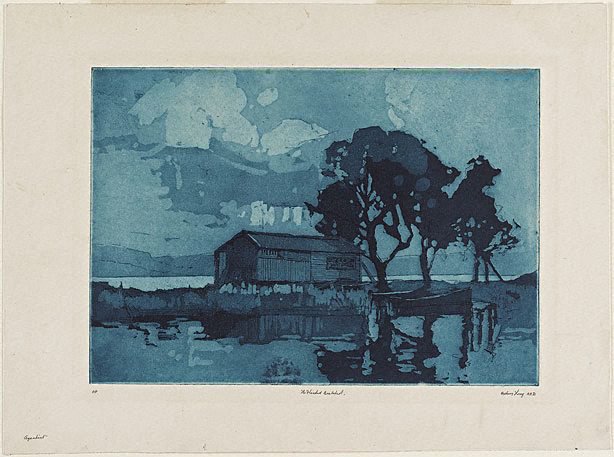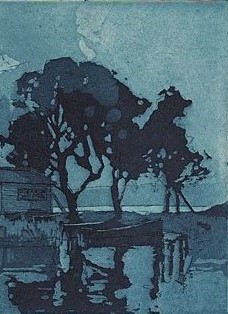THE FLOODED BOAT SHED
Art Gallery of NSW collection
Though small in scale and essentially simple, The Flooded Boatshed (exclusively rendered in tonal blues) is imbued with gentle undulating details giving it vitality whilst projecting a sense of poetic mastery and mystery.
The starkness of the trees (and consequent rippling shadows), arrest our attention propelling our eye upward and across to interrogate a background of unusual patches or blocks of tonal hues (most likely different densities of cloud formation), that hover above and settle our focus on the building. The almost centrally located boatshed emerges as an innocent and stable aspect of a capricious environment.

Sydney Long (Goulburn 1871 – London 1955), The Flooded Boatshed, undated c1928, etching, aquatint, printed in blue ink on paper, AP, image: 24.9 x 35.3cm (9.80″ x 13.89″); paper: 35 x 47.6cm (13.77″ x 18.74″), Signed by the artist

Sydney Long, The Flooded Boatshed (detail)
Despite the challenge of the dual printing processes, the scrappy details (as nature’s vicissitudes and diversity inevitably produce), lend an enchanting picturesque element.
Thus, although the composition is immaculately detailed, balanced and adept, it is also beguilingly and ‘spontaneously’ imperfect. This effect partly derives from the fussy etching and aquatint methods that manifest a little uncertainty in terms of ink and form outcomes, as well as the free and fluid immediacy, and its authoritative expression. Long embraced the style of art nouveau which can be detected here especially in the treatment of the trees and their shadows: the impression of lineal movement is a distinct characteristic of art nouveau and a palpable aspect of this work.

Sydney Long, The Flooded Boatshed (detail)
Additionally, there is a debt to 19th century Japanese prints. After Japan was forced to open up trade with the west (primarily by the American’s under Commodore Matthew Perry) in the 1850’s and 1860’s, European artist’s were able to study Japanese prints at close hand: generally flat, elementary and sinuous compositions. The Japanese print became the rage to emulate in the latter years of the century. Long had travelled through many parts of Europe in the quest to educate himself in art; studying in England and visiting France undoubtedly exposed him to the Japanese influence. Paris was under the spell of both art nouveau and the unconventional formal characteristics of the Japanese print.
The art dealer Siegfried Bing (1838 – 1905) was one of the earliest importers of Japanese decorative arts in Paris. He sold them in his shop La Porte Chinoise, as well as promoting them in his lavish magazine Le Japon Artistique, published from 1888-1891. Bing was also a major supporter of Art Nouveau a fin-de-siecle decorative style greatly influenced by Japonisme.

Sydney Long (Goulburn 1871 – London 1955), The Flooded Boatshed, undated c1928, etching, aquatint, printed in blue ink on paper, AP, image: 24.9 x 35.3cm (9.80″ x 13.89″); paper: 35 x 47.6cm (13.77″ x 18.74″), Signed by the artist (edges omitted for clarity)
The debt is clear and there is a lot to observe: especially the complicated perspective, stunning landscape components, foreground shadows, cloud formations, expanses of water and the boat nestling within the reeds adjacent to the trees. In spite of the arduous task of employing two printing techniques this little work is full of descriptive minutiae. The single use of blue in company with the soft moonlight compound the technical intricacies and profoundly affect the mood, as do the idiosyncratic shadows. These singularities enhance the surface patterns which are an important aspect in the appreciation of the print because the patterns draw our attention to every aspect of the composition and forms: small isolated sections work alone or in harmony within the entire complicated scene. No mean feat given its diminutive size.
The Flooded Boatshed is curious, engrossing and rigorous. While the work is visually powerful, an intoxicating tranquillity and dream-like quality pervade the landscape.
Australian Dictionary of Biography: Sydney Long (1871 – 1955)
Sydney Long (1871-1955), painter and etcher, was born on 20 August 1871 at Ifield, Goulburn, New South Wales, posthumous fifth child of James Long, Irish commission agent, and his native-born wife Susan, née Fletcher. He was educated at Goulburn Boys’ High School, and about 1888, the date of his first extant painting, moved to Sydney where he worked for some years at Sandeman’s, wine and spirit merchants in George Street. From about 1890 he studied under AL Daplyn and Julian Ashton at the Art Society of New South Wales’s school. When he first exhibited with the society in 1893 he was awarded second prize in the life class and in painting, and the president’s prize. Next year his first major painting, ‘By Tranquil Waters’, a self-consciously Impressionist study of boys bathing at Cook’s River, attracted widespread, mostly favourable critical attention, and was purchased by the National Art Gallery of New South Wales.
Becoming a full-time painter, Long supplemented his income by teaching private pupils…
Long…finally managed to leave Australia in 1910, reaching London in October. [Long met dancer Catherine Brennan in 1911 and they married in 1924]. In 1911 he enrolled at an art school at Kennington and soon associated himself with the more conservative tendencies in British art. He visited France, Belgium and Holland in 1912, but remained firmly Anglocentric. One of the continuing problems of Long’s London years was his lack of financial security. He had arranged for the Sydney dealer Adolph Albers to sell works on consignment. During World War I transport of these works became irregular as did payment, and he was often impoverished.
In 1921 Long returned to Australia for eighteen months, held successful exhibitions in Sydney and was a founding member of the Australian Painter-Etchers’ Society (later president). In 1925 he returned with his wife to settle at Lane Cove, with a caravan at Narrabeen and a studio in George Street. His pupil Donald Friend remembered him as ‘a very odd man indeed: envious, jealous, professionally and emotionally very timid: no close friends, only cronies. He yearned after the young, but discouraged actual friendliness. He was a debunker and “a knocker”. Very lonely I think‘.
From 1912 he had been sending works to the Royal Art Society and on his return continued to favour it and taught at its school. He was a trustee of the Art Gallery in 1933-49 and strongly opposed the foundation of the Australian Academy of Art. Long remained one of Australia’s leading etchers until the collapse of the etching boom in the mid-1930s, when he turned again to painting. In 1938 and 1940 he won the Wynne prize for landscape painting.
His later years were characterized by hostility to younger avant-garde artists and bitterness towards more successful artists of his generation. Late in life he under-stated his age by seven years. In 1952 Long and his wife left for London where he died on 23 January 1955 and was buried in Streatham cemetery.





















